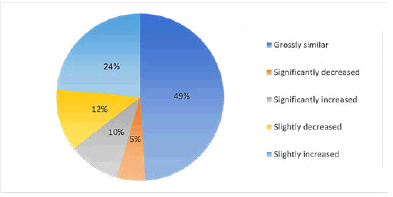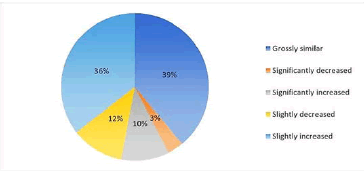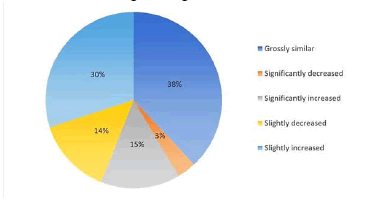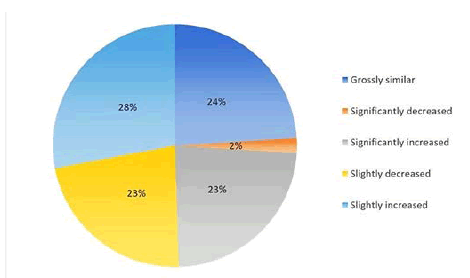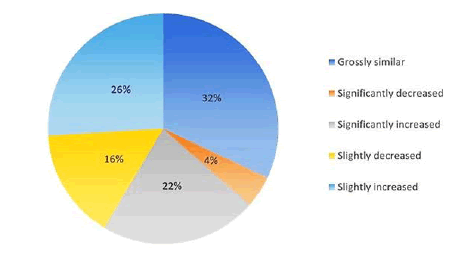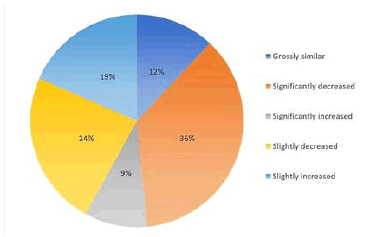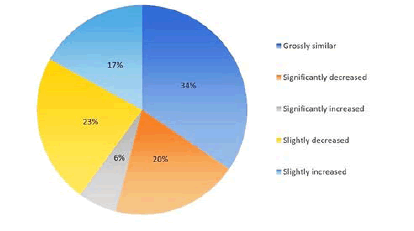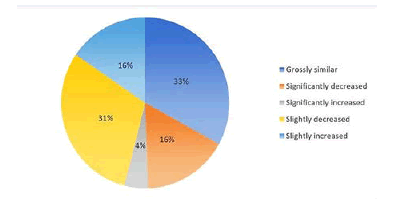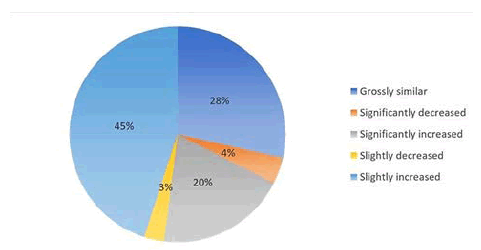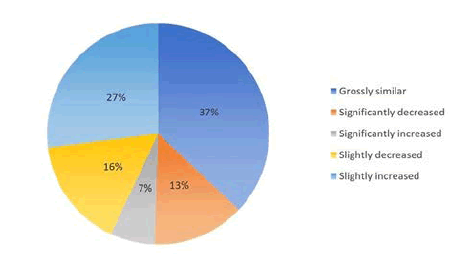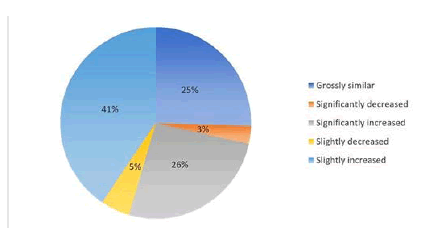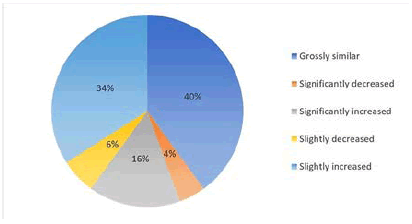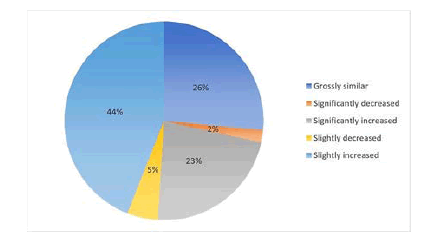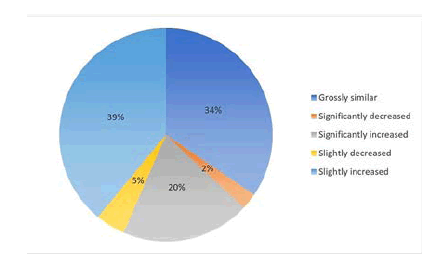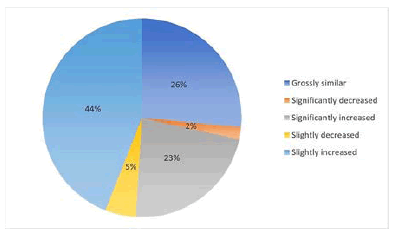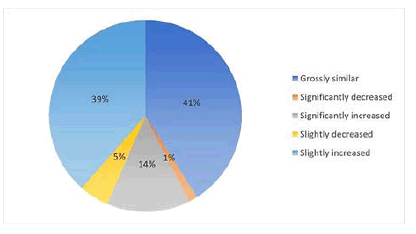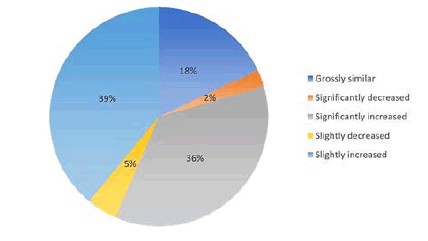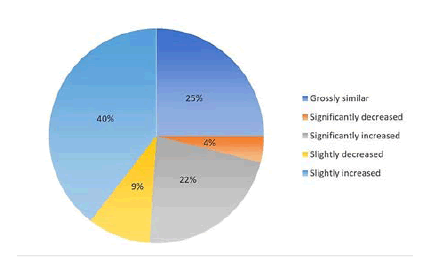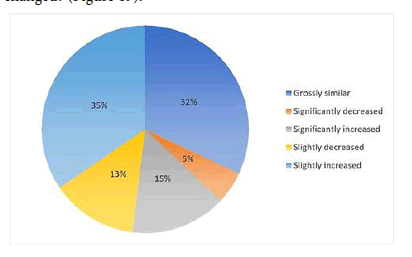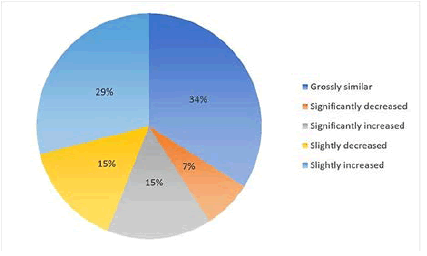Impact of COVID-19 on Changes in Lifestyle Related Behaviour in Undergraduate Male Physical Education Students
Received: 30-Aug-2022 / Manuscript No. jcmhe-22-73512 / Editor assigned: 01-Sep-2022 / PreQC No. jcmhe-22-73512 (PQ) / Reviewed: 15-Sep-2022 / QC No. jcmhe-22-73512 / Revised: 20-Sep-2022 / Manuscript No. jcmhe-22-73512 (R) / Published Date: 27-Sep-2022
Abstract
The objective of the study was to assess the changes in lifestyle related behaviour during COVID-19 in undergraduate male physical education students. To assess the lifestyle related changes in behaviour during COVID-19 pandemic, the lifestyle related changes in behaviour was administered on the selected and the scoring was done as per the instructions laid down by the authors. Pie chart was used to depict the responses of the subjects to all the 20 questions laid down in the questionnaire.
Based on the findings of the study following recommendations are drawn:
1. Similar study may be undertaken on men from other college.
2. Similar study may be undertaken on women also.
3. Similar study may be conducted with different age groups.
4. Similar study can be taken up by investing other physical, physiological and psychological parameters
5. While a body of literature examining the potential impacts of this period on physical activity and dietary habits is emerging, there has been stress for more research on the topic.
6. Previous studies have begun to investigate the effects of the newly adopted physical activity and dietary behaviors for children, the elderly and adult populations, but it is important to obtain information from all populations.
Keywords: COVID-19; Physical activity; Stress; Sedentary behaviour; Healthy lifestyle; Lockdown
Introduction
Designing safe mobile clinics in the age of COVID-19: A medical design collaboration
Coronavirus disease (COVID-19), which originated in the Wuhan province of China, was declared as a global pandemic by the World Health Organization (W.H.O) on March 11, 2020. Since then, it has spread beyond borders and affected the lifestyles behaviour of people. This pandemic not only adversely affected the physical health of individuals, but also brought forth significant changes in their lifestyle. India has a widely recognized health care delivery system but due to the lack of organized infrastructure, there is a growing sense of crisis, as the majority (66.53%) of its population reside in rural areas which are plagued with wide discrepancies related to the delivery of health care needs. Needless to say, this pandemic has magnified this dearth by diverting its focus on specific medical conditions, neglecting other issues related to lifestyle behaviour.
The spread of the COVID-19 (SARS-CoV-2) pandemic all over the world has forced countries to handle the crisis in different ways, declaring a national state of alarm and establishing a mandatory home lockdown. The COVID-19 infection represents a strong stress stimulus, which has the capacity to induce high levels of perceived risk, fear, and anger, while forced quarantine at home may provoke an experience of boredom and loneliness, eliciting negative mental and behavioural responses in people [1]. It seems that the more time people remained at home, the more intense the resulting mental, emotional and lifestyle problems [2]. This situation has disrupted life and consequently altered multifaceted lifestyle behaviours. As a consequence, collateral damages of the pandemic are represented by inadequate nutrition with a risk of either overweight or underweight, addiction to screens, social isolation, disrupted sleep, and reduced physical activity with increased sedentariness: all these indirect effects of the COVID-19 outbreak have a potential mental health impact, particularly for vulnerable groups, and require effective and targeted measures.
In the last year, the new coronavirus (SARS-CoV-2) has become a global sanitary emergency. The pandemic itself, and the measures adopted to combat it have changed our lifestyle. The consequences are not only measured in the number of lives lost, but also in its economic and social impact. Lifestyle is currently considered a multidimensional construct, which integrates behaviors from nutrition, physical activity, restorative sleep, outdoor activities, substance use, stress management and social support. So far there is no radical treatment for the COVID-19 infection, and the only way to battle this pandemic is by increasing awareness and prevention through the implementation of isolation measures and enhancement of the function of the immune system. To combat the COVID-19, many countries have applied preventive measures such as disinfection procedures and partial or complete lockdown to slow the spread of the virus. Regarding exercise, several studies suggest that almost half of the participants became less active during the quarantine, which in turn was associated with lower subjective well-being and lower health related quality of life. Engaging in physical activity during confinement has been consistently associated with better outcomes on anxiety or mood disorders worldwide [3,4]. Changes in environmental exposures and increased screen time, such as TV, smartphone, and Internet usage, represent an expected consequence of confinement.
Moreover, reducing the use of screen based devices combined with outdoor exercise had more l benefits for mental health than either healthy behaviour alone [5]. This new situation may limit access of individuals to daily shopping and affect their choices for a healthy balanced diet with subsequent dependence on highly processed, ready to eat cereals and junk foods, which are high in salt, sugar, and fats. Such dietary habits will increase the risk factors of chronic diseases like obesity, heart disease, stroke, type 2 diabetes, some cancers, and chronic kidney disease. Moreover, restricted movement due to lockdown may force many people to stay home and to limit their physical activities and results in more sedentary behaviour, which is associated with an increased risk of chronic disease [6].
Noteworthy is the fact that gyms and recreational areas were also included in the lockdown closures and hence were not available for individuals to exercise and carry out leisure physical activity. Furthermore, it has been reported that the lockdown measures could be associated with distressing experience and boredom because the situation is taking the world into uncharted waters. Such circumstances could be triggered by a loss of usual routine and reduced social and physical contact with others [6]. Studies have shown that sleep is crucial for emotional and mental wellbeing and helps to confront stress and anxiety. However, sleep patterns of individuals during pandemic containment could be disturbed.
During this period, citizens have been forced to be isolated at home, prioritizing telecommuting and remaining at home except for “essential” tasks (e.g., purchasing groceries and medications, assisting those who are sick or disabled); therefore, outdoor physical activities have been suspended. Inevitably, this confinement is associated with a series of changes in our daily life activities, which usually lead to a sedentary behaviour characterized by decreases in physical activity [7,8], increased sedentary (sitting) behaviour [9], and an increase in the use of screen devices [10]. There is a major concern regarding the adverse effects of physical inactivity due to personal restrictions and how changes in the lifestyle would result in a range of chronic health conditions [11]. Consequently, research on the effects of the pandemic restrictions on physical activity can be considered a global public health need.
Recent evidence suggests there is an independent association between sedentary behaviour and all-cause mortality, including cardiovascular disease. In fact, increased sitting time (i.e., >8 h/day) or screen time (3–4 h/day) are associated with increased risk of all-cause mortality, regardless of the levels of physical activity, and the deaths attributed to these unhealthy lifestyle behaviors are exponentially increasing in adults. Because the COVID-19 lockdown prevents individuals from leaving their homes, including preventing access to outside sidewalks, parks, or fitness facilities, this could lead to decreased physical activity and increased sedentary behaviour. The acute cessation of physical activity may incur metabolic and cardiovascular disturbances, promoting obesity and accelerating atherosclerotic disease [12]. For example, an abrupt decrease in the number of steps over a couple of week’s results in impaired insulin sensitivity and lipid metabolism [13]. Further, reduced physical activity levels and increased sedentary behaviors are known to affect the immune system and enhance the risk of severe infections in comparison to those who do regular physical activity and thereby can place an individual at greater risk of developing severe COVID-19 symptoms. Different organizations (e.g., WHO) have released guidelines for people in self-quarantine recommending sitting less and moving more while at home. In addition to the detriments to physical health, lack of physical activity and large amounts of sedentary behaviour are linked to psychological well-being, such as decreased mental health, including depression [14,15].
Moreover, other lifestyle habits (i.e., sleep) are able to modulate immune functions and improve the adaptive immune response against the antigen, even during COVID-19 outbreak [5]. Furthermore, the evidence is wide suggesting the positive association between sleep and mental health [3,16-18].
Changes in social life and the daily routine (i.e., loneliness, lower exposure to the sun, as well as increased use of electronic devices) together with the imposed stress on individuals (i.e., insecurity about their health or financial consequences), has also been reported to negatively affect sleep patterns [5,3], leading to high rates of sleeplessness. Low activity levels (during the day also) affect sleep negatively. Moreover, people spend more time using screens during the quarantine, and in young adults this was also associated with a growing prevalence of sleep problems. The use of screens can ameliorate social isolation; however, these behaviours (e.g., smartphone use) can have a negative influence on the levels of physical activity, sedentary behaviour, and sleep patterns [19]. Likewise, different coping strategies have been recommended by the WHO to address the psychological effects of the COVID-19 outbreak, including rest, physical activities, and staying in contact with family and friends. Moreover, reductions in media viewing 90 min before bedtime have also been advised [20-29].
Despite the attempts to prevent the changes in physical activity, sedentary behaviour (e.g., sitting or media use), and sleep forced by the lockdown, the evidence is limited regarding the effect of confinement on physical activity, sedentary behaviour, smartphone use, and sleep patterns [7]. Further, all of the previous studies on this topic have used subjective tools; therefore, objective and quantitative ways to monitor population behaviour are required in order to determine the impact of the measures adopted by the government and suggest strategies for possible confinements in the near future. By means of built in sensors in smartphones and wearable technologies, the remote monitoring of human behaviour is possible and consequently, lifestyle modifications during this time could be recommended. The present paper presents preliminary data on physical activity, sedentary behaviour, smartphone use, and sleep patterns before and during home confinement during the COVID-19 lockdown, collected from wearable devices (including step counts and sleep patterns) and by smartphones (smartphone usage), which may be altered by changes in lifestyle due to social isolation. Specifically, we aimed at determining to what extent physical activity, sedentary behaviour, smartphone use, and sleep patterns changed during the COVID-19 lockdown, and to investigate which lifestyle factors should be considered as moderators of these changes. Our hypothesis was that COVID-19 lockdown will result in less physical activity, greater sedentary behaviour, greater smartphone use, and high sleep amount and quality than pre COVID-19 lockdown.
Health related quality of life (HRQoL) has been defined as the level of wellbeing consequent from the evaluation that a person makes of diverse domains of his life, considering the impact these have on his health status. It is characterized as subjective, multidimensional, and changing over time. The HRQoL assessment incorporates at early ages the perception of physical, psychological, and social wellbeing according to evolutionary development and individual differences, within a specific cultural context, and considers the ability to fully participate in the activities and the physical, social, and psychosocial functions appropriate to their age. Children with poor HRQoL are less likely to develop normally and mature into healthy adults [30].
Many children and adolescents in developed countries lead sedentary lifestyles, reduced active leisure activities, and increased reliance on sedentary lifestyles [31]. Before the COVID-19 pandemic, a previous study stated that 81% of students aged 11–17 years were insufficiently physically active [32]. Independently of physical activity levels, sedentary activities, especially those based on the use of electronic devices, are associated with an increased risk of obesity, a reduction in physical condition, self-esteem, and prosocial behaviour. In this regard, the COVID-19 pandemic has increased the amount of screen recreational time. This is quite relevant since a previous systematic review of reviews indicated that the evidence that screen time was associated with poorer HRQoL was moderate.
In addition to inactivity, stressful situations such as coronavirus disease 2019 (COVID-19) pandemic have affected the HRQoL of children. Home quarantine conditions and the use of the Internet or mobile phones have also been effective in creating these conditions. The COVID-19 pandemic has led to rapid, unprecedented changes to the lives of billions of children and adolescents [33-40].
Furthermore, as commented before, restriction in mobility, social distancing, or school closures have been increased sedentary behaviour. Thus, it is expected that HRQoL would be reduced in children and adolescents. Previous studies have indicated that HRQoL have been reduced due to COVID-19 [26,27] whereas others did not find differences [28,29]. However, to the best of our knowledge, no systematic review has synthesized the existing results in order to clarify this divergence.
Based on the evident literature the research scholar felt need to undertake research to assess the changes in the lifestyle relate behaviours because of COVID-19 in the physical education students.
Objectives
To assess the changes in lifestyle related behaviour due to COVID-19 in undergraduate male physical education students.
Delimitations
• The study was delimited to male students pursuing undergraduate in physical education from I.G.I.P.E.S.S.
• The age group of the subjects selected for the study was between 17 to 25 years.
• The study was delimited to the changes in lifestyle related behaviour due to COVID-19 in the selected subjects.
Limitations
Questionnaire study has its own limitations. The mood state of the subject while responding to the items in the questionnaire, that is beyond the content of the scholar were considered as the limitation of the study.
Definition of related terms
Physical activity: Physical activity as any bodily movement produced by skeletal muscles that requires energy expenditure. Physical activity refers to all movement including during leisure time, for transport to get to and from places, or as part of a person’s work.
Sedentary behavior: Sedentary behavior is any waking behavior characterized by an energy expenditure ≤1.5 metabolic equivalents (METs), while in a sitting, reclining or lying posture. In general, this means that any time a person is sitting or lying down; they are engaging in sedentary behavior. Common sedentary behaviors include TV viewing, video game playing, computer use (collective termed “screen time”), driving automobiles, and reading [31].
COVID-19: Coronavirus disease (COVID-19) is an infectious disease caused by the SARS-CoV-2 virus. Most people who fall sick with COVID-19 will experience mild to moderate symptoms and recover without special treatment. However, some will become seriously ill and require medical attention.
Lockdown: Temporary condition imposed by governmental authorities (as during the outbreak of an epidemic disease) in which people are required to stay in their homes and refrain from or limit activities outside the home involving public contact (such as dining out or attending large gatherings).
Healthy lifestyle: Good nutrition, daily exercise and adequate sleep are the foundations of healthy living. A healthy lifestyle keeps you fit, energetic and at reduced risk for disease. According to WHO, Healthy living is a way of living that helps you enjoy more aspects of your life.
Eating behaviour: Eating behaviour is a complex interplay of physiologic, psychological, social, and genetic factors that influence meal timing, quantity of food intake, and food preference.
Stress: Stress is a feeling of emotional or physical tension. It can come from any event or thought that makes you feel frustrated, angry, or nervous. Stress is your body's reaction to a challenge or demand. In short bursts, stress can be positive, such as when it helps you avoid danger or meet a deadline [32-35].
Hypothesis
It was hypothesised that there would be significant changes observed in lifestyle related behaviour of the students because of the COVID-19.
Significance
The findings of the study shall prove significant in the following ways:
1. The findings of the study will provide preliminary evidence on dietary/nutritional and physical activity changes by the pandemic, among college students.
2. This research can hopefully aid in future studies and the development of public health strategies for combating these physical activity and dietary changes.
3. The findings of the study shall help people understand the association between positive lifestyle and health.
4. The findings of the study shall motivate the people to consume a healthy diet and regularly engage in physical activity to maintain and/or improve physical health.
A global pandemic and quarantine period are a novel experience which is greatly impacting people; therefore, it is important to begin investigating the extent to which it has affected our physical well-being [36].
Procedure and Methodology
A detailed description of Selection of subjects, the Selection of Variables, Criterion Measures, Administration of Questionnaire and Collection of Data and Statistical Techniques Employed.
Selection of subjects
For the purpose of the study two hundred (N=200) male physical education students pursuing undergraduate degree were selected as subjects for the study. The age group of the subject ranged from 17 to 25 years.
Selection of variables
For the purpose of the present study the following variable was selected Changes in lifestyle related behaviour due to COVID-19.
Criterion measures
The following was the criterion measures selected for the purpose of the study: The changes in the lifestyle related behaviours due to COVID-19 were assessed by administering the changes in the lifestyle behaviour during COVID-19 [37].
Description of the questionnaire
The data was collected from the selected subjects after the administration of a questionnaire assessing “lifestyle behaviour” during COVID-19. The Lifestyle related behaviour changes questionnaire contains 20 statements and the response scale is anchored “significantly increased, slightly increased, grossly similar, slightly decreased, significantly decreased” [38].
Scoring instructions for the Lifestyle Related Behaviour Changes:
Items 1, 2, 6, 7, 8, 9*, 10, 17 and 20 are scored as:
2=Significantly decreased
1=Slightly decreased
0=Slightly increased
0=Significantly increased
Items 4, 5, 11, 12, 13, 14, 15, 16 and 19 are scored as:
2=significantly increased
1=slightly increased
0=grossly similar
0=slightly decreased
2=significantly decreased
Item 3**, 18*** is scored as:
0=grossly similar
0=slightly increased/decreased
0=significantly increased/decreased
(*Item 9 is scored assuming that these recipes are usually high in calories. **Item 3 is scored assuming that the person was having normal portion of meals and snacks before COVID-19 pandemic. **Item 18 is scored assuming that the individual was having an adequate 6-8 hours’ sleep before pandemic).
Analysis of Data and Results of the Study
A total of two hundred (N=200) male students pursuing Undergraduate degree in Physical Education (BSc (PE, HE and S)) from Indira Gandhi Institute of Physical Education and Sports Sciences, University of Delhi, participated in the survey. Their age ranged between 17 and 25 years. The data was collected and analyzed by using SPSS version 16.0. This research was based on the assessment of lifestyle related changes during COVID-19 and the subsequent data analysis and results of the study have been presented in this chapter. The lifestyle related behaviour change questionnaire, that was administered on the selected subjects were analysed statistically and the 20 questions responded by the subjects are presented below [35-42].
1. During COVID-19 pandemic, how has your probability of skipping one of the main meals (breakfast/lunch/dinner) changed? (Figure 1).
From the above pie chart pertaining to the probability of skipping one of the main meals (breakfast/lunch/dinner) among the selected subjects, it is evident that 49% of the subjects revealed gross similar changes; 24% revealed a slight increase; 12% revealed slight decrease; 10% revealed a significant increase;5% revealed significant decrease.
2. During COVID-19 pandemic, how has your habit of snacking between meals changed? (Figure 2).
From the above pie chart pertaining to the changes in the habit of snacking between meals among the selected subjects, it is evident that 39% of the subjects revealed gross similar changes; 36% revealed a slight increase; 12% revealed slight decrease; 10% revealed a significant increase; 3% revealed a significant decrease.
3. During COVID-19 pandemic, how has your quantity/portions of meals and snacks changed? (Figure 3).
From the above pie chart pertaining to the changes in the quantity/ portions of meals and snacks among the selected subjects, it is evident that 38% of the subjects revealed gross similar changes; 30% revealed a slight increase; 15% revealed a significant increase; 14% revealed slight decrease; 3% revealed a significant decrease.
4. During COVID-19 pandemic, how has your daily intake of fruits and vegetables changed? (Figure 4).
From the above pie chart pertaining to the changes in the daily intake of fruits and vegetables among the selected subjects, it is evident that 28% of the subjects revealed slight increased changes; 24% revealed a gross similar change; 23% revealed slight decrease;23% revealed a significant increase;2% revealed significant decrease.
5. During COVID-19 pandemic, how has your intake of a balanced diet (including healthy ingredients such as whole wheat, pulses, legumes, eggs, nuts, fruits and vegetables) changed? (Figure 5).
From the above pie chart pertaining to the changes in the intake of balanced diet including healthy ingredients such as whole wheat, pulses, legumes, eggs, nuts, fruits and vegetables among the selected subjects, it is evident that 32% of the subjects revealed gross similar changes; 26% revealed a slight increase; 22% revealed a significant increase; 16% revealed slight decrease; 4% revealed a significant decrease.
6. During COVID-19 pandemic, how has your consumption of junk food/fast food and fried food changed? (Figure 6).
From the above pie chart pertaining to the changes in the consumption of junk food/fast food and fried food among the selected subjects, it is evident that 36% of the subjects revealed a significant decrease; 24% revealed slight decrease; 19% revealed a slight increase; 12% revealed grossly similar changes; 9% revealed a significant increase.
7. During COVID-19 pandemic, how has your intake of sugar sweetened beverages (carbonated soft drinks, sugar sweetened juices) changed? (Figure 7).
From the above pie chart pertaining to the changes in the intake of sugar sweetened beverages (carbonated drinks, sugar sweetened juices) among the selected subjects, it is evident that 34% of the subjects revealed gross similar changes;23% revealed slight decrease; 20% revealed a significant decrease; 17% revealed a slight increase; 6% revealed a significant increase.
8. During COVID-19 pandemic, how has your consumption of sweets/candies/chocolate changed? (Figure 8).
From the above pie chart pertaining to the changes in the consumption of sweets/candies/chocolate among the selected subjects, it is evident that 33% of the subjects revealed gross similar changes; 31% revealed slight decrease; 16% revealed a slight increase;16% revealed significant decrease; 4% revealed a significant increase.
9. During COVID-19 pandemic, how has your participation in cooking new/traditional recipes changed? (Figure 9).
From the above pie chart pertaining to the changes in the participation in cooking new/traditional recipes among the selected subjects, it is evident that 45% of the subjects revealed slight increased changes; 28% revealed gross similar changes; 20% revealed a significant increase; 4% revealed a significant decrease; 3% revealed a slight decrease.
10. During COVID-19 pandemic, how has your consumption of unhealthy food when you are bored or stressed or upset changed? (Figure 10).
From the above pie chart pertaining to the changes in the consumption of unhealthy food when they are bored or upset among the selected subjects, it is evident that 37% of the subjects revealed gross similar changes; 27% revealed a slight increase;16% revealed a slight decrease 13% revealed a significant decrease; 7% revealed significant increase.
11. During COVID-19 pandemic, how has your intake of immunity boosting foods (decrease; fruits and green leafy vegetables) in the diet changed? (Figure 11).
From the above pie chart pertaining to the changes in the habit of intake of immunity boosting foods such as decrease; fruits and green leafy vegetables among the selected subjects, it is evident that 41% of the subjects revealed slight increase changes; 26% revealed a significant increase; 25% of the subjects revealed gross similar changes; 5% revealed slight decrease; 3% revealed a significant decrease.
12. During COVID-19 pandemic, how has your intake of nutrition supplements to boost immunity changed? (Figure 12).
From the above pie chart pertaining to the changes in the habit of intake of nutrition supplement to boost immunity change among the selected subjects it is evident that 40% of the subjects revealed gross similar changes; 34% revealed a slight increase; 16% revealed a significant increase; 6% revealed a slight decrease; 4% revealed significant decrease.
13. During COVID-19 pandemic, how has the support of your family and friends in eating healthy changed? (Figure 13).
From the above pie chart pertaining to the changes in the habit of support of their family in eating healthy among the selected subjects, it is evident that 44% of the subjects revealed slight increase changes; 26% revealed gross similar changes; 23% revealed a significant increase; 5% revealed a slight decrease; 2% revealed significant decrease.
14. During COVID-19 pandemic, how has your interest in learning healthy eating tips from the media (newspaper articles/magazines blogs/videos/TV shows/text messages) changed? (Figure 14).
From the above pie chart pertaining to the changes in taking interest in learning healthy eating tips from the media such as newspaper articles, magazines blogs, videos and TV shows among the selected subjects, it is evident that 39% revealed a slight increase change; 34% revealed a gross similar change; 20% revealed a significant increase; 5% revealed slight decrease; 2% revealed a significant decrease.
15. During COVID-19 pandemic, how has your participation in aerobic exercise changed? (Figure 15).
From the above pie chart pertaining to the changes in the habit of participating in aerobic exercise among selected subjects, it is evident that 30% of the subjects revealed slight increase changes; 26% revealed a grossly similar changes; 22% revealed significant increase; 16% revealed a slight decrease; 6% revealed significant decrease.
16. During COVID-19 pandemic, how has your participation in leisure and household chores changed? (Figure 16).
From the above pie chart pertaining to the changes in the participation in leisure and household chores among the selected subjects, it is evident that 41% of the subjects revealed gross similar changes; 39% revealed slight increase; 14% revealed significant increase; 5% revealed a slight decrease; 1% revealed a significant decrease.
17. During COVID-19 pandemic, how has your sitting and screen time changed? (Figure 17).
From the above pie chart pertaining to the changes in the habit of sitting and screen time among the selected subjects, it is evident that 39% of the subjects revealed slight increased changes; 36% revealed significant increase changes; 18% revealed grossly similar; 5% revealed slight decrease; 2% revealed a significant decrease.
18. During COVID-19 pandemic, how have your hours of sleep changed? (Figure 18).
From the above pie chart pertaining to the changes in the hours of sleep among the selected subjects, it is evident that 40% of the subjects revealed slight increase changes; 25% revealed grossly similar changes; 22% revealed significant increase; 9% revealed slight decrease; 4% revealed a significant decrease.
19. During COVID-19 pandemic, how has your quality of sleep changed? (Figure 19).
From the above pie chart pertaining to the changes in the quality of sleep among the selected subjects, it is evident that 35% of the subjects revealed slight increased changes; 32% revealed grossly similar changes; 15% revealed significant increase; 13% revealed slight decrease; 5% revealed significant decrease.
20. During COVID-19 pandemic, how have your stress and anxiety levels changed? (Figure 20).
From the above pie chart pertaining to the changes in the levels of stress and anxiety among the selected subjects, it is evident that 34% of the subjects revealed gross similar changes; 29% revealed a slight increase; 15% revealed slight decrease; 15% revealed significant increase; 7% revealed a significant decrease.
This study reveals that there is no change in the lifestyle related behaviour among (31.35%) male graduate physical education students of IGIPESS. 31.9% students reveal slight increase in lifestyle related behaviour. Out of 200 students, 16.75% revealed significant increase in lifestyle related behaviour.12.9% students revealed slight decrease and 7.1% students revealed significant decrease in lifestyle related behaviour (Table 1).
| Questions | Grossly Similar | Significantly Decreased | Significantly Increased | Slightly Decreased | Slightly Increased |
|---|---|---|---|---|---|
| Skipping main Meal | 49% | 5% | 10% | 12% | 24% |
| Habit of Snacking | 39% | 3% | 10% | 12% | 36% |
| Quantity/portions Of meals | 38% | 3% | 15% | 14% | 30% |
| Intake of Fruits & vegetables | 24% | 2% | 23% | 23% | 28% |
| Intake of Balance diet | 32% | 4% | 22% | 16% | 26% |
| Consumption of junk Food/fast food | 12% | 36% | 9% | 24% | 19% |
| Intake of Sugar sweetened Beverages | 34% | 20% | 6% | 23% | 17% |
| Consumption of sweets/ Candies/chocolate | 33% | 16% | 4% | 31% | 16% |
| Participation in cooking New/traditional recipes | 28% | 4% | 20% | 3% | 45% |
| Consumption of unhealthy Food when bored | 37% | 13% | 7% | 16% | 27% |
| Intake of immunity- Boosting foods | 25% | 3% | 26% | 5% | 41% |
| Intake of nutrition supplements | 40% | 4% | 16% | 6% | 34% |
| Support of family & Friends in eating healthy | 26% | 2% | 23% | 5% | 44% |
| Interest in learning healthy Eating tips | 34% | 2% | 20% | 5% | 39% |
| Participation in Aerobic exercise | 26% | 6% | 22% | 16% | 30% |
| Participation in leisure and household chores | 41% | 1% | 14% | 5% | 39% |
| Change in sitting and screen time | 18% | 2% | 36% | 5% | 39% |
| Change in hours of Sleep | 25% | 4% | 22% | 9% | 40% |
| Change in Quality of sleep | 32% | 5% | 15% | 13% | 35% |
| Change in stress & Anxiety levels | 34% | 7% | 15% | 15% | 29% |
| Total | 31.35% | 7.10% | 16.75% | 12.90% | 31.90% |
Table 1: Percentage of participant’s responses.
Discussion of Findings
Based on the assessment of lifestyle related behaviour changes during COVID-19 in the undergraduate male physical education students the following were the observations:
A grossly similar pattern was observed in the skipping of main meal; intake of balanced diet; intake of sugar sweetened beverages; consumption of sweets/candies/chocolates; consumption of unhealthy food when bored; intake of nutrition supplement; change in stress and anxiety levels.
A slight increase was observed in participation in new/traditional recipes; intake of immunity boosting foods; support of family and friends in eating healthy; participation in aerobic exercise; sitting and screen time; hours of sleep; quality of sleep.
COVID-19 is a global burden which continues to redefine daily lifestyle related habits in a significant manner as the pandemic progresses through its different phases. Public health recommendations and government measures taken to abate infection have indirectly impacted food availability, dietary quality, normal daily activities, and access to recreational public settings, social activities, work and financial security [43]. Regular meal pattern as a construct is often described as an individual’s eating patterns at the level of a ‘meal’, such as a main meal (for example, breakfast, lunch or dinner) or a smaller sized meal (for example, supper or snack) [44]. The consumption of nutritionally balanced small and frequent meals is associated with better dietary quality and is a common clinical recommendation for weight loss and reduction in metabolic comorbidities [45].
Recommendations
During the COVID-19 pandemic the Indian government implemented lockdown in which students were urged to leave their homes as little as possible and study from home. This life changing event may have caused changes in lifestyle behaviour, an important factor in the onset and course of diseases. The overarching aim of this study was to determine life style related changes during the COVID-19 pandemic among a representative sample of graduate students at Indira Gandhi Institute of Physical Education and Sports Science, University of Delhi.
Life style related changes in behaviour were studied among physical education students’ representing sample of the graduate students in the Indira Gandhi Institute using an online survey conducted from February to April 2022. Differences in COVID-19 related lifestyle changes between students were determined. The electronic survey questionnaire was designed to assess changes in multiple lifestyle related behaviors such as eating, physical activity, sleep and other health related behaviours during the COVID-19 outbreak. The survey included a questionnaire of 20 questions on lifestyle related measures, anxiety, and need for support to maintain lifestyle changes.
Conclusion
The following were the conclusions drawn from the findings of the present study:
• It was observed that the ‘probability of skipping one of the main meals’ during COVID-19 did not change among the students and was grossly similar.
• It was observed that the ‘habit of snacking between meals’ during COVID-19 did not change among the students and was grossly similar.
• It was observed that the ‘change in the quantity/portions of the meals and snacks during COVID-19 did not change and was grossly similar.
• It was observed that the ‘daily intake of fruits and vegetables’ during COVID-19 increased.
• It was observed that the intake of a balanced diet including healthy ingredients such as whole wheat, pulses, legumes, eggs, nuts, fruits and vegetables during COVID-19 did not change and was grossly similar.
• It was observed that the ‘consumption of junk food/fast food and fried food’ during COVID-19 decreased.
• It was observed that ‘intake of sugar sweetened beverage carbonated soft drinks, sugar sweetened juices during COVID-19 did not change and was grossly similar.
• It was observed that the ‘consumption of sweets/candies/chocolates’ during COVID-19 was not changed and was grossly similar.
• It was observed that ‘the participation in cooking new/traditional recipes’ during COVID-19 was increased.
• It was observed that ‘consumption of unhealthy food when subjects are bored or stressed or upset’ during COVID-19 was not changed and was grossly similar.
• It was observed that the intake of immunity boosting foods (lemon, turmeric, garlic, citrus fruits and green leafy vegetables) in the diet during COVID-19 was increased.
• It was observed that the intake of nutrition supplements to boost immunity during COVID-19 did not change and was grossly similar.
• It was observed that the support of the family and friends in eating healthy during COVID-19 increased.
• It was observed that the interest in learning healthy eating tips from the media (newspaper articles/magazine blogs/videos/TV shows/ text messages) during COVID-19 increased.
• It was observed that the participation in aerobic exercise during COVID-19 did increase.
• It was observed that the participation in leisure and household chores during COVID-19 did not changed and was grossly similar.
• It was observed that the sitting and screen time during COVID-19 was increased.
• It was observed that the hours of sleep during COVID-19 had increased.
• It was observed that the quality of sleep during COVID-19 had increased.
• It was observed that the stress and anxiety levels during COVID-19 did not change and was grossly similar.
Acknowledgement
I feel immense pleasure to express my gratitude to all those people who have made this article possible and I would cherish my bachelor’s experience throughout my life.
First and foremost, I offer my sincere gratitude to my guide Dr. Sandhya Tiwari, Professor, I.G.I.P.E.S.S (University of Delhi), B-block, Vikaspuri, New Delhi. From finding an appropriate subject in the beginning to the process of writing dissertation. Dr. Sandhya Tiwari offered her unreserved help and guidance step by step. Her words always inspired me and brought mine thinking process at a higher level. Without her patient and kind instruction, it was impossible for me to finish this dissertation work at time. I hope that one day I would become as good advisor to my students as mam has been to me. Due to her guidance and constant interest, the dissertation completed well in time. I am very much indebted to her.
Sincere thanks to the entire staff of I.G.I.P.E.S.S, University of Delhi for providing necessary literature and material for the study time to time.
Heartfelt thanks to all my friends, for their consistent support and contribution done in the work.
I would love to thank my parents Mr. Dharam Vir Singh and Mrs. Krishna Kumari who have always been supported and motivated me for an excellence level of work in everything and for being driving force in my life.
Everything cannot be mentioned, but nothing is forgotten. Finally, I would like to place on record my sincere gratitude and thanks to I.G.I.P.E.S.S, University of Delhi for giving this opportunity to undertake this study.
References
- Marano G, Traversi G, Gesualdi A, Biffi A, Gaetani E, et al. (2021) Mental health and coaching challenges facing the COVID-19 outbreak. Psychiatr Danub. 33(1):124-126.
[Google Scholar] [PubMed]
- Yang X, Peng S, Yang T, Cottrell R (2021) Changing trends of mental and behavioral responses and associations during the COVID-19 epidemic in China: A panel study. Health Educ Res, 36(2):151-158.
[Crossref] [Google Scholar] [PubMed]
- López-Bueno R, López-Sánchez G, Casajús J, Calatayud J, Gil-Salmerón A, et al. (2020) Health-related behaviors among school-aged children and adolescents during the spanish COVID-19 confinement. Front Ped. 8.
- Zhang C, Yang L, Liu S, Ma S, Wang Y, et al. (2020) Survey of insomnia and related social psychological factors among medical staff involved in the 2019 novel coronavirus disease outbreak. Front Psych, 11:306.
[Crossref] [Google Scholar] [PubMed]
- Abdulah D, Musa D (2020) Insomnia and stress of physicians during COVID-19 outbreak. Sleep Med. 2:100017.
- Katzmarzyk P, Lear S (2011) Physical activity for obese individuals: A systematic review of effects on chronic disease risk factors. Obesity Reviews. 13(2): 95-105.
- Ammar A (2020) Effects of COVID-19 home confinement on eating behaviour and physical activity: Results of the eclb-COVID-19 international online survey. Nutr. 12(6): 1583.
- De Oliveira Neto L, Elsangedy H, Tavares V, Teixeira C, Behm D, et al. (2022) #TrainingInHome - Home-based training during COVID-19 (SARS-COV2) pandemic: Physical exercise and behavior-based approach. Convergence.19(2).
- Abid R, Ammar A, Maaloul R, Souissi N, Hammouda O (2021) Effect of COVID-19 related home confinement on sleep quality, screen time and physical activity in tunisian boys and girls: A survey. Intern J Environ Res Pub Health. 18(6): 3065.
- Kumari A, Ranjan P, Vikram N, Kaur D, Sahu A, et al. (2020) A short questionnaire to assess changes in lifestyle-related behaviour during COVID-19 pandemic. Diabetes & Metabolic Syndrome: Clinical Research & Reviews. 14(6):1697-1701.
- Lippi G, Henry B, Sanchis-Gomar F (2020) Physical inactivity and cardiovascular disease at the time of coronavirus disease 2019 (COVID-19). European J Prev Cardiol. 27(9):906-908.
- Charansonney OL (2011) Physical activity and aging: A life-long story. Discovery Med.
- Krogh-Madsen R, Thyfault J, Broholm C, Mortensen O, Olsen R, et al. (2010) A 2-wk reduction of ambulatory activity attenuates peripheral insulin sensitivity. J of Applied Physiology. 108(5):1034-1040.
- Mandolesi L, Polverino A, Montuori S, Foti F, Ferraioli G, et al. (2018) Effects of physical exercise on cognitive functioning and wellbeing: Biological and psychological benefits. Front Psychol. 9.
- De Moor M, Beem A, Stubbe J, Boomsma D, De Geus E (2006) Regular exercise, anxiety, depression and personality: A population-based study. Prev Med. 42(4):273-279.
- Hosker D, Elkins R, Potter M (2019) Promoting mental health and wellness in youth through physical activity, nutrition, and sleep. Child and Adolescent Psychiatric Clinics of North America. 28(2):171-193.
- Brauer A (2019) Sleep and health among collegiate student athletes. Chest. 156(6): 1234-1245.
- Altena E (2020) Dealing with sleep problems during home confinement due to the COVID‐19 outbreak: Practical recommendations from a task force of the European CBT‐I Academy. J Sleep Res. 29(4).
- Grimaldi-Puyana M, Fernández-Batanero J, Fennell C, Sañudo B (2020) Associations of objectively-assessed smartphone use with physical activity, sedentary behavior, mood, and sleep quality in young adults: A cross-sectional study. Intern J Environ Res Pub Health. 17(10):3499.
- Cheval B (2020) Relationships between changes in self-reported physical activity, sedentary behaviour and health during the coronavirus (COVID-19) pandemic in France and Switzerland. J Sports Sci. 39(6): 699-704.
- Cellini N, Canale N, Mioni G, Costa S (2020) Changes in sleep pattern, sense of time and digital media use during COVID‐19 lockdown in Italy. J Sleep Res. 29(4).
- Guthold R, Stevens G, Riley L, Bull F (2020) Global trends in insufficient physical activity among adolescents: A pooled analysis of 298 population-based surveys with 1.6 million participants. Lancet Child Adolesc Health. 4(1):23-35.
- Gopinath B, Hardy L, Baur L, Burlutsky G, Mitchell P (2012) Physical activity and sedentary behaviors and health-related quality of life in adolescents. Pediatr. 130(1):e167-e174.
- Chtourou H (2020) Staying physically active during the quarantine and selfisolation period for controlling and mitigating the COVID-19 pandemic: A systematic overview of the literature. Front Psychol.11.
- Fazeli S, Mohammadi Zeidi I, Lin C, Namdar P, Griffiths M, et al. (2020) Depression, anxiety, and stress mediate the associations between internet gaming disorder, insomnia, and quality of life during the COVID-19 outbreak. Addict Behav Rep.12:100307.
- Dragun R, Veček N, Marendić M, Pribisalić A, Đivić G, et al. (2020) Have lifestyle habits and psychological well-being changed among adolescents and medical students due to COVID-19 lockdown in croatia?. Nutr. 13(1):97.
- de Matos D (2020) The impact of measures recommended by the government to limit the spread of coronavirus (COVID-19) on physical activity levels, quality of life, and mental health of brazilians. Sustain. 12(21):9072.
- Alothman S, Alghannam A, Almasud A, Altalhi A, Al-Hazzaa H (2021) Lifestyle behaviors trend and their relationship with fear level of COVID-19: Crosssectional study in Saudi Arabia. PLOS ONE. 16(10): e0257904.
- Fresneda J (2022) Psychological wellbeing of vulnerable children during the COVID-19 pandemic. Psicothema. 32.
- Orgilés M, Morales A, Delvecchio E, Mazzeschi C, Espada J (2020) Immediate psychological effects of the COVID-19 quarantine in youth from italy and spain. Front Psychol.11.
- Bertrand L (2021) The impact of the coronavirus disease 2019 (COVID-19) pandemic on university students’ dietary intake, physical activity, and sedentary behaviour. App Physiol Nutri Metab. 46(3): 265-272.
- Celis-Morales C (2018) Associations of discretionary screen time with mortality, cardiovascular disease and cancer are attenuated by strength, fitness and physical activity: Findings from the UK biobank study. BMC Med. 16(1).
- Celorio-Sardà R (2021) Effect of COVID-19 lockdown on dietary habits and lifestyle of food science students and professionals from spain. Nutr. 13(5): 1494.
- Chen P, Mao L, Nassis G, Harmer P, Ainsworth B, et al. (2020) Coronavirus disease (COVID-19): The need to maintain regular physical activity while taking precautions. J Sport Health Sci. 9(2): 103-104.
- Copeland W, Keeler G, Angold A, Costello E (2007) Traumatic events and posttraumatic stress in childhood. Arch General Psych. 64(5):577.
- Dunton G, Do B, Wang S (2020) Early effects of the COVID-19 pandemic on physical activity and sedentary behavior in children living in the U.S. BMC Public Health. 20(1).
- Hawryluck L, Gold W, Robinson S, Pogorski S, Galea S, et al. (2004) SARS control and psychological effects of quarantine, toronto, canada. emerging infectious diseases. 10(7): 1206-1212.
- Hermassi S, Hayes L, Salman A (2021) Physical activity, sedentary behavior, and satisfaction with life of university students in qatar: Changes during confinement due to the COVID-19 pandemic. Frontiers in Psychology.12.
- Huckins J (2020) Mental health and behavior of college students during the early phases of the COVID-19 pandemic: longitudinal smartphone and ecological: Momentary assessment study. Journal of Medical Internet Research. 22(6): e20185.
- Ingram J, Maciejewski G, Hand C (2020) Changes in diet, sleep, and physical activity are associated with differences in negative mood during COVID-19 lockdown. Frontiers in Psychology. 11.
- Kilani H (2020) Healthy lifestyle behaviors are major predictors of mental wellbeing during COVID-19 pandemic confinement: A study on adult Arabs in higher educational institutions. PLOS ONE, 15(12): e0243524.
- Orben A, Tomova L, Blakemore S (2020) The effects of social deprivation on adolescent development and mental health. Lancet Child Adolesc Health. 4(8):634-640.
- Mattioli AV, Pinti M, Farinetti A, Nasi M (2020) Obesity risk during collective quarantine for the COVID-19 epidemic. Obes Med. 20:100263.
- Leech RM, Worsley A, Timperio A, McNaughton SA (2015) Understanding meal patterns: Definitions, methodology and impact on nutrient intake and diet quality. Nutrition research reviews. 28(1):1-21.
- Jon Schoenfeld B, Albert Aragon A, Krieger JW (2015) Effects of meal frequency on weight loss and body composition: A meta-analysis. Nutrition reviews. 73(2):69-82.
Citation: Gautam AP (2022) Impact of COVID-19 on Changes in Lifestyle Related Behaviour in Undergraduate Male Physical Education Students. J Comm Med Health Educ 12:779.
Copyright: © 2022 Gautam AP. This is an open-access article distributed under the terms of the Creative Commons Attribution License, which permits unrestricted use, distribution, and reproduction in any medium, provided the original author and source are credited.
Share This Article
Recommended Journals
Open Access Journals
Article Usage
- Total views: 2069
- [From(publication date): 0-2022 - Apr 11, 2025]
- Breakdown by view type
- HTML page views: 1726
- PDF downloads: 343

